Life During Wartime
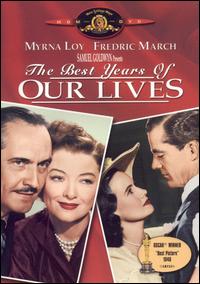 The Best Years of Our Lives
The Best Years of Our LivesPN1997 .B47 1991
When Samuel Goldwyn decided to make The Best Years of Our Lives, Hollywood was running away from World War II-related scripts as though the subject itself had the plague--movies about men in uniform had been box-office poison since early 1945. The assumption was that returning veterans would be even less willing than those who'd stayed on the home front to shell out money to be reminded of their service. Goldwyn, director William Wyler, and screenwriter Robert E. Sherwood (working from MacKinlay Kantor's blank verse novel Glory For Me), and a cast from heaven (some of them, like Dana Andrews and Virginia Mayo, giving the greatest performances of their careers) proved the industry wrong, and they opened up a whole new subject area by focusing on the men giving up their uniforms, the women and children around them, and even the men who hadn't served. They ended up with a 170-minute movie whose every shot was dramatically and psychically spellbinding, embracing the relief, anxiety, pain, joy, and doubts that Americans could now express. The setting of the movie in a small city somewhere in the middle of the country gave it a Norman Rockwell veneer, while the script melded that background with some healthy cynicism and emotional honesty borne out of the movie world's new awareness of modern psychology. Thus, the film had its feet in both pre-war and post-war consciousness, appealing to two generations of filmgoers (or even three, as the World War I-era audience was still around and had hardly been served well in its own time). It not only set new standards for maturity in mainstream movie-making, showing that you could please crowds even as you showed a few unpleasant truths about who and what we were, but also did a lot to ease audiences into the Hollywood era that produced such serious, topical dramas as Gentleman's Agreement, Crossfire, City Across the River, Home of the Brave, The Sound of Fury (aka Try and Get Me), The Wild One, On the Waterfront, and Goldwyn's own Edge of Doom. ~Bruce Eder, All Movie Guide
Watch the trailer:
Watch a clip from the film
Watch another clip from the film
Das Boot is among the most realistic of all World War II films and one of the most spectacular object lessons in manipulating and choreographing the space on the screen. Director Wolfgang Petersen manages to convey the long periods of boredom for the crew of a submarine while making that boredom interesting for the audience. The film is largely unconcerned with the issues surrounding World War II, instead focusing on the individual sailors aboard the sub. Cinematographer Jost Vacano is continually creative in finding new things to reveal aboard the cramped quarters of the sub, and the film's intensity is impressive. The scene in which the sub's captain (Jürgen Prochnow) sinks what he thinks is an unoccupied enemy ship, only to find that it isn't, is among the most memorable scenes in any war film. There are few films that can maintain interest for such a lengthy running time with so few sets to work with, but Das Boot does exactly that for all 210 minutes of the expanded, post-release director's cut. ~Richard Gilliam, All Movie Guide
Watch the trailer courtesy of The Internet Movie Database (so is the advertisement)
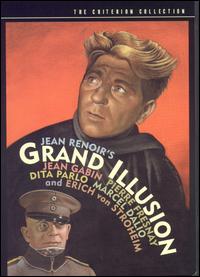 Grand Illusion
Grand IllusionPN1997 .G681 1990
A "poetic realist" masterpiece, Jean Renoir's Grand Illusion (1937) eloquently revealed the absurdity of war in a story about escape from a World War I German prison camp. One of the first sound film masters of the mobile camera, Renoir structured his film through a series of long takes in deep focus, moving gracefully yet subtly among the characters to embed them in rather than isolate them from their environments. With this observational style, Renoir examined the "grand illusions" threatening Europe in the 1930s and humankind in general: war and the artificial distinctions of class and nation that drive it. Each of the four main characters stands for a particular social stratum, with their metaphorical places revealed through realistic details of conversation and quotidian behavior. This emphasis on the reality of daily life in prison camps, complete with dialogue in several languages and easygoing camaraderie between prisoners and guards, suggests the core of humanity shared by all, regardless of class, language, and cultural divisions. The poetic final image of an invisible border hidden beneath an expanse of white snow punctuates Renoir's benevolently humanist stance. Grand Illusion was a hit in the U.S. as well as in France, even receiving an Oscar nomination for Best Picture; it also received a special prize at the 1937 Venice Film Festival despite being banned in Italy and Germany. Regularly listed as one of the best films ever made, Grand Illusion's power remains undiminished, while the impact of Renoir's audacious style can be seen from the work of Orson Welles to the French New Wave. ~Lucia Bozzola, All Movie Guide
Watch a clip from Grand Illusion
Director and film historian Peter Bogdanovich introduces Grand Illusion for Turner Classic Movies' The Essentials
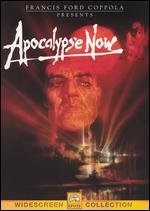
Apocalypse Now
PN1997 .A66 2000
PN1997 .A66 2000
One of a cluster of late-1970s films about the Vietnam War, Francis Ford Coppola's Apocalypse Now adapts the Joseph Conrad novella Heart of Darkness to depict the war as a descent into primal madness. Capt. Willard (Martin Sheen), already on the edge, is assigned to find and deal with AWOL Col. Kurtz (Marlon Brando), rumored to have set himself up in the Cambodian jungle as a local, lethal godhead. Along the way Willard encounters napalm and Wagner fan Col. Kilgore (Robert Duvall), draftees who prefer to surf and do drugs, a USO Playboy Bunny show turned into a riot by the raucous soldiers, and a jumpy photographer (Dennis Hopper) telling wild, reverent tales about Kurtz. By the time Willard sees the heads mounted on stakes near Kurtz's compound, he knows Kurtz has gone over the deep end, but it is uncertain whether Willard himself now agrees with Kurtz's insane dictum to "Drop the Bomb. Exterminate them all." Coppola himself was not certain either, and he tried several different endings between the film's early rough-cut screenings for the press, the Palme d'Or-winning "work-in-progress" shown at Cannes, and the final 35 mm U.S. release (also the ending on the video cassette). The chaotic production also experienced shut-downs when a typhoon destroyed the set and star Sheen suffered a heart attack; the budget ballooned and Coppola covered the overages himself. These production headaches, which Coppola characterized as being like the Vietnam War itself, have been superbly captured in the documentary, Hearts of Darkness: A Filmmaker's Apocalypse. Despite the studio's fears and mixed reviews of the film's ending, Apocalypse Now became a substantial hit and was nominated for eight Academy Awards, including Best Picture, Best Director, Best Supporting Actor for Duvall's psychotic Kilgore, and Best Screenplay. It won Oscars for sound and for Vittorio Storaro's cinematography. This hallucinatory, Wagnerian project has produced admirers and detractors of equal ardor; it resembles no other film ever made, and its nightmarish aura and polarized reception aptly reflect the tensions and confusions of the Vietnam era. ~Lucia Bozzola, All Movie Guide
Watch the trailer:
Watch Martin Sheen discuss the film in a clip from Inside the Actors Studio:
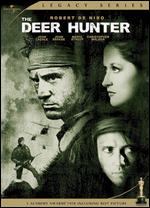 The Deer Hunter
The Deer HunterPN1997 .D44 2001
Realizing that the three-hour film would need to be a prestige event to draw public interest, Universal followed Grease producer Allan Carr's advice and opened The Deer Hunter for one week for Academy Award consideration in December 1978, putting off the national opening until February 1979. The gambit succeeded. The film won the Best Picture prize from the New York Film Critics' Circle and got nine Academy Award nominations as it went into national release, including Best Picture, Best Director, and acting nods for Robert De Niro, Christopher Walken, and Meryl Streep. The movie went on to beat Coming Home for Best Picture and Best Director and also picked up Oscars for Walken's performance, Sound, and Editing. As the film's acclaim grew, it also aroused objections to the depiction of the Vietcong as racist from, among others, Coming Home star Jane Fonda, as well as criticisms from numerous Vietnam reporters that director Michael Cimino was ill-informed about real Vietnam experience, not having served in the war himself. Regardless of the disputes over the veracity of the Russian roulette scenes, they create an indelible metaphor for warfare and its atmosphere of sudden, random violence. While the press notes suggest that the final song was meant to be affirmative, the searing sense of loss that builds up throughout the film renders it profoundly ambiguous. This combination of ambivalence, brutality, and controversy echoed American culture's experience of Vietnam, making The Deer Hunter an even more telling cultural artifact than may have been intended. The film's awards and acclaim manifested Hollywood's willingness finally to reckon one way or another with a war that had been all but absent from movie screens while it was happening, leading the way for such later films as Stanley Kubrick's Full Metal Jacket (1987) and Oliver Stone's Platoon (1986) and Born on the Fourth of July (1989). With the prizes and dissension, The Deer Hunter became a popular hit, enabling Cimino to have full artistic freedom for his next film, the financially disastrous Heaven's Gate. ~Lucia Bozzola, All Movie Guide
Watch the trailer:
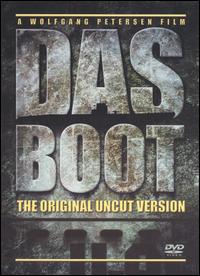
0 Comments:
Post a Comment
<< Home